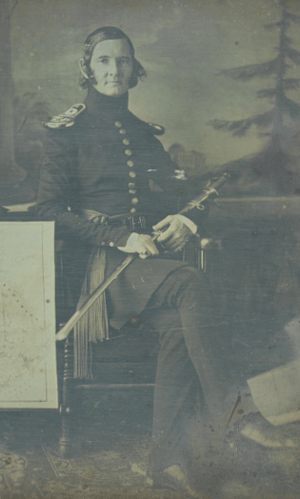James Duncan Graham facts for kids
Quick facts for kids
James Duncan Graham
|
|
|---|---|

James Duncan Graham c. 1845
|
|
| Born | April 1, 1799 |
| Died | December 28, 1865 (aged 66) Boston, Massachusetts
|
| Nationality | American |
| Occupation | Topographic engineer |
| Spouse(s) |
Charlotte Meade
(m. 1828; died 1843)Frances Wickham
(m. 1857) |
James Duncan Graham (born April 1, 1799 – died December 28, 1865) was an important American engineer. He helped create the Corps of Topographical Engineers. This group mapped out land and helped build important projects. Graham was a "topographical engineer," which means he was an expert at surveying and mapping land. He helped redraw the famous Mason–Dixon line. He also worked on the borders between the United States and Canada, and between the United States and Mexico. He also oversaw improvements in harbors on the Great Lakes. Graham even studied the lunar tide in those lakes.
Contents
Early Life and Family
James Duncan Graham was born on April 1, 1799. His parents were William and Mary Campbell Graham. They lived in Prince William County, Virginia.
Education and Early Military Role
James went to the United States Military Academy (West Point). He studied there from 1813 to 1817. After graduating, he became a third lieutenant in the artillery. He also worked as an assistant at the academy for a while.
Family Life
In 1828, James married Charlotte Meade. Her father was a merchant named Richard W. Meade. Charlotte's brother, George Meade, became a famous general in the Civil War. James and Charlotte had sons who also served in the military. After Charlotte passed away, James married Frances Wickham.
Early Career as a Topographical Engineer
Graham's career began with exciting explorations. From 1819 to 1821, he joined Stephen Harriman Long's team. They explored areas that the United States bought in the Louisiana Purchase.
Mapping and Railroad Surveys
For several years, Graham worked on mapping projects. He surveyed land in Vermont in 1829. Later, he helped survey for railroads. These included the Winchester and Potomac Railroad in Virginia. He also worked on railroad surveys in Alabama, Florida, and Georgia.
Military Service and Border Work
During the Second Seminole War, Graham served in Florida. He worked under Major General Thomas Jesup. After that, he surveyed for military defenses in Missouri in 1838.
Graham also became an astronomer for the United States. He helped mark the border between the U.S. and the Republic of Texas. This was from 1839 to 1840. He then worked on the Northeast Boundary of the United States.
Defining the U.S. and Canada Border
From 1843 to 1847, Graham was very busy. He was the main astronomer for marking the border between the United States and Canada. This was part of the Webster–Ashburton Treaty. His work was so important that he was promoted to lieutenant-colonel. He helped remake maps of this border after a fire destroyed the originals.
Later Career and Important Projects
In the 1850s, Graham continued his important work. He helped survey the famous Mason–Dixon line from 1849 to 1850.
U.S. and Mexico Border
From 1850 to 1851, he was the main astronomer for the border between the United States and Mexico. This border was set after the Mexican–American War by the Treaty of Guadalupe Hidalgo.
Great Lakes Improvements
Graham also oversaw many harbor improvements. He worked on harbors on Lake Michigan from 1854 to 1856. He also improved the channel on the St. Clair Flats. From 1856 to 1864, he was the chief engineer for harbor improvements on the North and Northwestern Lakes. During this time, he even found evidence of a lunar tide in the Great Lakes around 1859.
Civil War and Final Years
During the American Civil War, Graham led the United States Lake Survey. He also worked as a lighthouse engineer for some districts. In 1864, his loyalty to the Union was questioned. He was briefly investigated and removed from his job.
Later, he worked on sea-walls in Boston Harbor. He also took charge of repairing harbor works along the Atlantic Coast. This included areas from Maine to the Chesapeake. James Duncan Graham passed away in Boston on December 28, 1865. He is buried in Congressional Cemetery in Washington, D.C..
Legacy
James Duncan Graham is remembered in science and geography. Three types of reptiles are named after him: Anolis grahami, Regina grahamii, and Salvadora grahamiae. A mountain, Mount Graham, is also named in his honor. Graham County, Arizona is named after this mountain.
Images for kids

